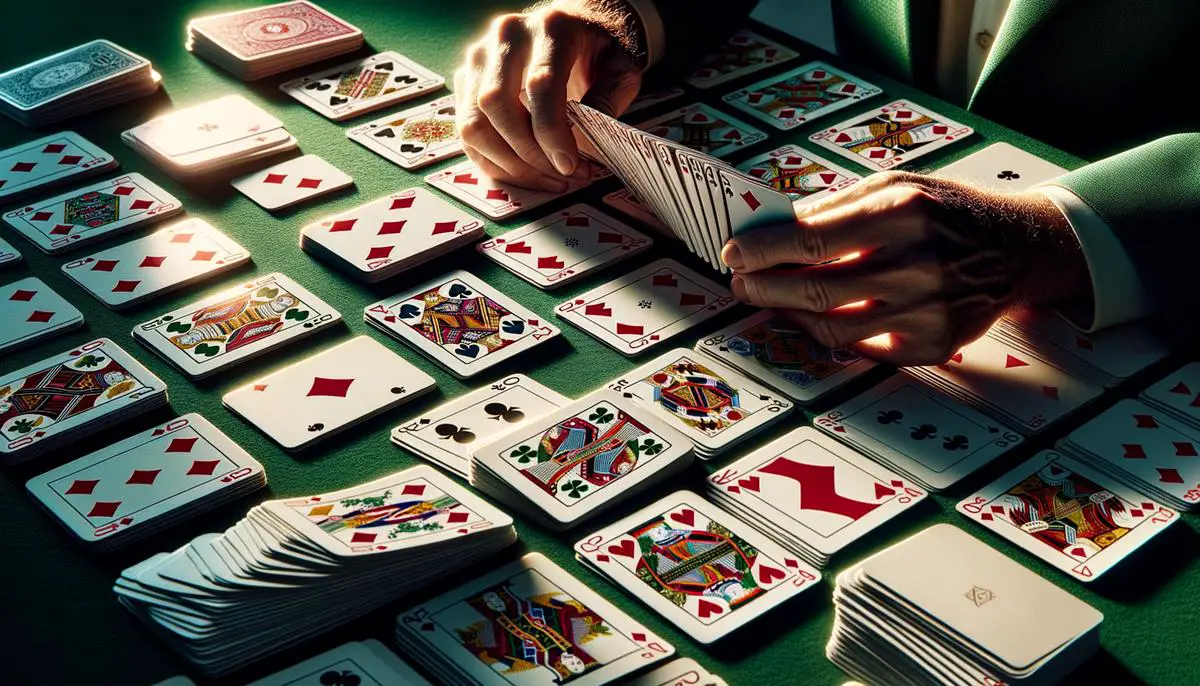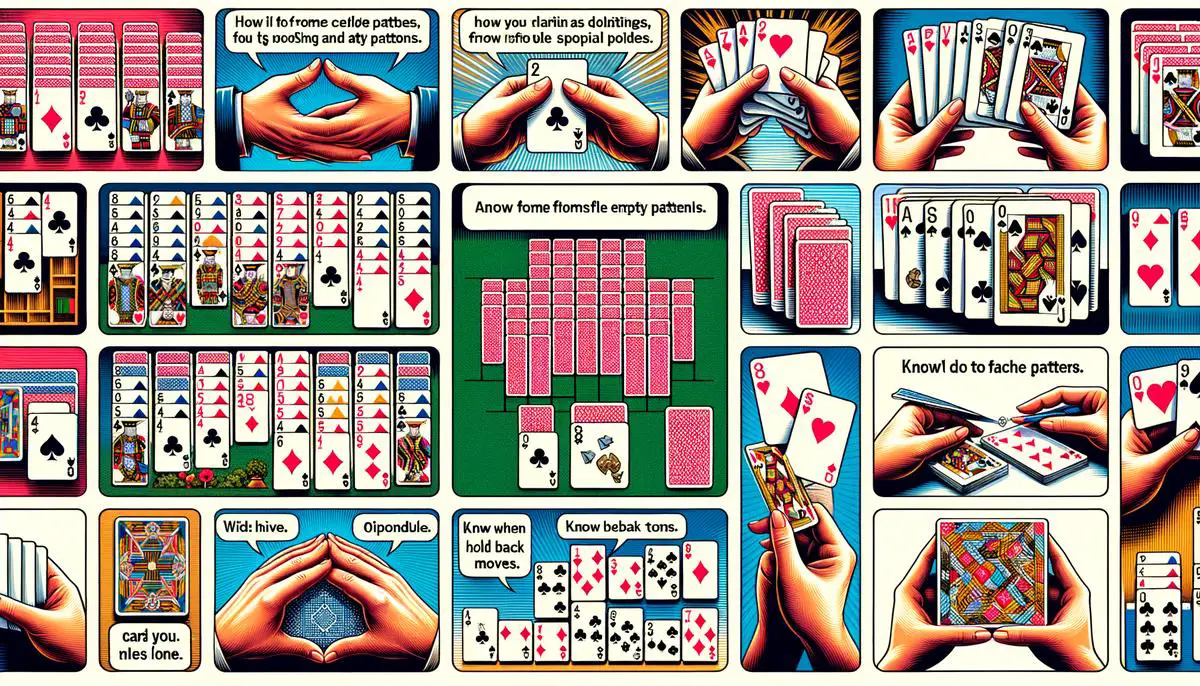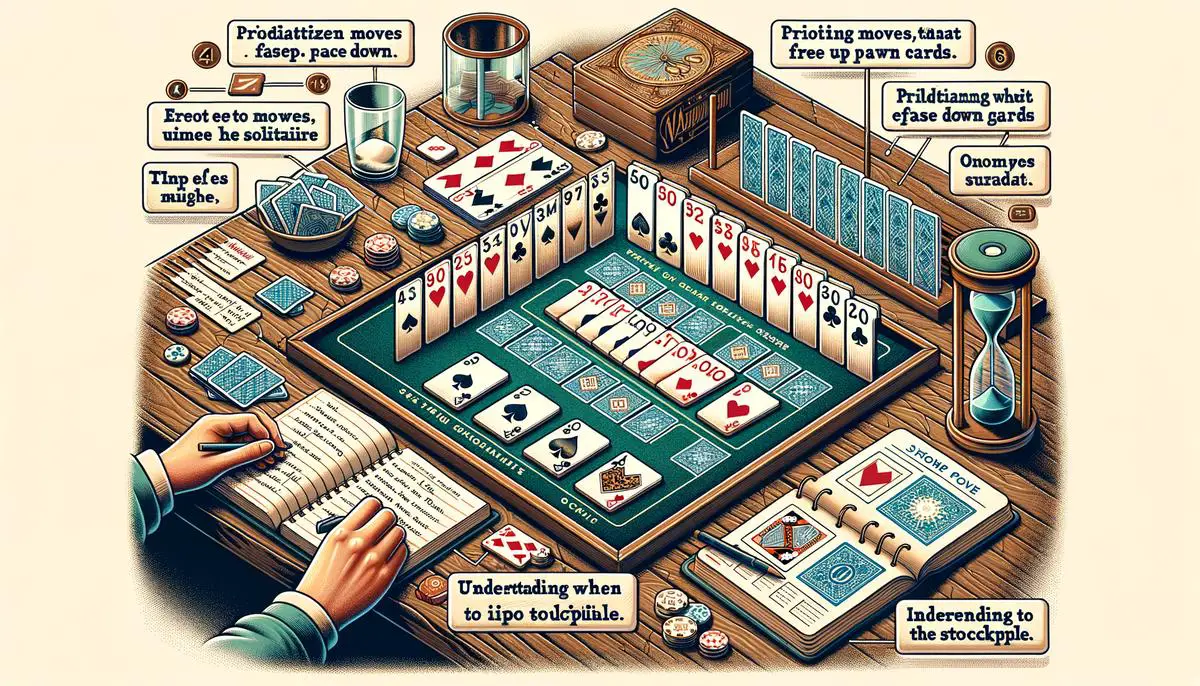Solitaire, a game of both strategy and chance, invites players into a world where each move matters. As we explore the intricacies of this beloved card game, from its basic rules to advanced strategies, our guide aims to enhance your understanding and gameplay. Whether you’re a seasoned player looking to refine your techniques or a beginner learning the ropes, the insights offered here will provide valuable tools for improving your Solitaire game.
Understanding Solitaire Rules
Solitaire, often known as Patience, is a card game that you can play by yourself. The goal is to move all the cards to a foundation, organizing them by suit from Ace to King. Here’s how you can play the classic version, also known as Klondike Solitaire:
Set up the game: Use a standard 52-card deck. Shuffle the cards well. Lay out seven piles of cards face down in a row. The first pile has one card, the second has two, and so on until the seventh pile has seven cards. Flip the top card of each pile face up. The remaining cards form a draw pile.
Understand the tableau: The seven piles you laid out are called the tableau. You’ll mainly work with these cards to organize them onto the foundation piles.
Start the foundation piles: As Aces become available, move them above the tableau to start the foundation piles. Each foundation pile will be built in ascending order (Ace to King) and must be of the same suit.
Play the cards on the tableau: On the tableau, cards can be arranged in descending order and must be of alternating colors (red and black). For instance, you can place a black 6 on a red 7. You can move individual cards or sequences of aligned cards between the piles. If you uncover a face-down card, flip it over. If a tableau pile becomes empty, you can place a King there, either alone or with a sequence of cards.
Use the draw pile: If you can’t make any more moves on the tableau, draw cards from the draw pile. You can flip over one card at a time and try to use it either on the tableau or place it on the foundation piles. If you can’t use the drawn card, set it aside in a waste pile and draw another. When you go through the draw pile, reshuffle the waste pile to create a new draw pile.
Winning the game: You win Solitaire by building up all the foundation piles in ascending order from Ace to King in their respective suits. This means organizing all the cards into these foundations.
Remember, not all Solitaire games can be won. Sometimes, you’ll find yourself in a position where no more moves are possible. When this happens, start a new game and try again. With patience and strategy, you’ll find yourself getting better and more successful at Solitaire.

Setting Up the Solitaire Game
Shifting our focus to strategic moves, it’s essential for players to master how to efficiently use the tableau and foundation piles to their advantage. This skill is pivotal in navigating through complex game situations and inching closer towards victory. Let’s dive into effective strategies that can elevate your Solitaire gameplay:
Maximize the Tableau Piles:
Always be on the lookout for opportunities to reveal hidden cards in the tableau. Moving cards from one tableau pile to another, or to the foundation, can uncover valuable cards trapped beneath. This not only provides more options but also helps clear the tableau, inching you closer to winning.
Foundation Piles Strategy:
Begin building your foundation piles early, but do so wisely. Prioritize placing lower-ranked cards first, as this establishes a solid foundation and opens up more maneuverability for higher-ranked cards as the game progresses. Keep the suits in mind to efficiently build up each foundation pile.
Keep an Eye on the Draw Pile:
The draw pile is your lifeline, supplying new cards that can be played either on the tableau or directly to the foundation piles. Use it judiciously. Remember, every time you cycle through the draw pile, your options may become more limited. Plan your moves to ensure you’re not blocking yourself from accessing essential cards later in the game.
Empty Tableau Spaces:
A clear tableau space is a powerful tool. It gives you the flexibility to move any card or sequenced pile into this space. Use these opportunities to reorganize the tableau in favor of revealing more hidden cards or strategically planning future moves. Kings are typically the go-to cards for filling empty tableau spaces.
Strategic Card Movement:
Always consider the consequences of moving a card from one place to another. Ask yourself, “Does this move bring me closer to revealing a hidden card or building up my foundation piles?” Sometimes, the best move is to wait until the best option presents itself rather than rushing to fill a space.
By integrating these strategies into your Solitaire gameplay, you’ll find yourself developing a keen eye for impactful moves, optimizing the way you utilize the draw pile, and ultimately, increasing your chances of winning. Remember, Solitaire is not just a game of luck but a test of strategy and foresight. Each move should be deliberate and aimed at unlocking new possibilities. Happy playing!

Basic Solitaire Strategies
Given that we’ve covered the basics of Solitaire, including the mechanics and strategies, let’s dive into additional tactics to enhance your winning potential. These strategies are aimed at refining your gameplay, ensuring that you inch closer to victory with each move. Remember, while Solitaire may seem like a game of luck, the outcome heavily depends on the choices you make.
Expose Hidden Cards:
Prioritize moves that allow you to turn over the hidden cards in the tableau. Uncovering these cards not only gives you more options but also increases your chances of making meaningful plays. This step is crucial in expanding your playing field and opening up new possibilities for organizing your cards.
Be Mindful of Color and Rank:
When rearranging cards on the tableau, pay close attention to the color and rank. Alternating colors is a must, but strategic planning in terms of sequencing can set you up for smoother transitions between piles. This consideration is key in orchestrating your moves for both immediate and future actions.
Hold Onto Aces and Twos:
Although it might be tempting to move Aces and Twos to the foundation piles immediately, sometimes waiting can be strategic. Evaluate your tableau and consider if keeping these cards a little longer could open up advantageous moves. This method is particularly useful when you’re dealing with a tight game and need every card to work in your favor.
Wisely Use the Undo Button:
Most digital versions of Solitaire offer an undo button. Use this feature to your advantage to explore different strategies without penalty. This can be especially helpful in learning the consequences of certain moves and understanding better tactics for future games.
Ensure Mobility is Maintained:
Always aim to maintain at least one empty slot in your tableau if possible. This slot acts as a “parking space” for maneuvering other cards around, significantly increasing your mobility. A stuck tableau is often the downfall in Solitaire – flexibility is a cornerstone for winning.
Be Strategic with the Draw Pile:
Instead of using the first playable card from the draw pile, review all uncovered cards first. Planning your moves ensures that you’re not missing out on a more strategic play elsewhere. Remember, every card played from the draw pile can alter the trajectory of the game.
Patience is Key:
As the name suggests, Patience (another name for Solitaire) is not just about quick wins but strategic, thoughtful play. Rushing through without considering all options can lead to a dead-end. Take your time to assess the board and think a few moves ahead.
By integrating these strategies into your play, you significantly bolster your chances of winning at Solitaire. While each game presents its unique challenges, approaching it with a blend of patience, strategy, and foresight will steer you towards victory more often than not. And remember, the beauty of Solitaire lies in the journey as much as the outcome. Each game is an opportunity to refine your approach and sharpen your problem-solving skills. Enjoy the process, and happy playing!

Mastering Solitaire requires more than just understanding the rules; it demands a strategic mindset and a willingness to adapt. By applying the strategies and tactics outlined in this guide, players can approach their Solitaire games with confidence and a better chance of winning. Remember, every game is an opportunity to improve your skills, develop your strategies, and enjoy the satisfaction that comes from playing this timeless card game. So, shuffle the deck, lay out your cards, and let the games begin. Happy playing!
